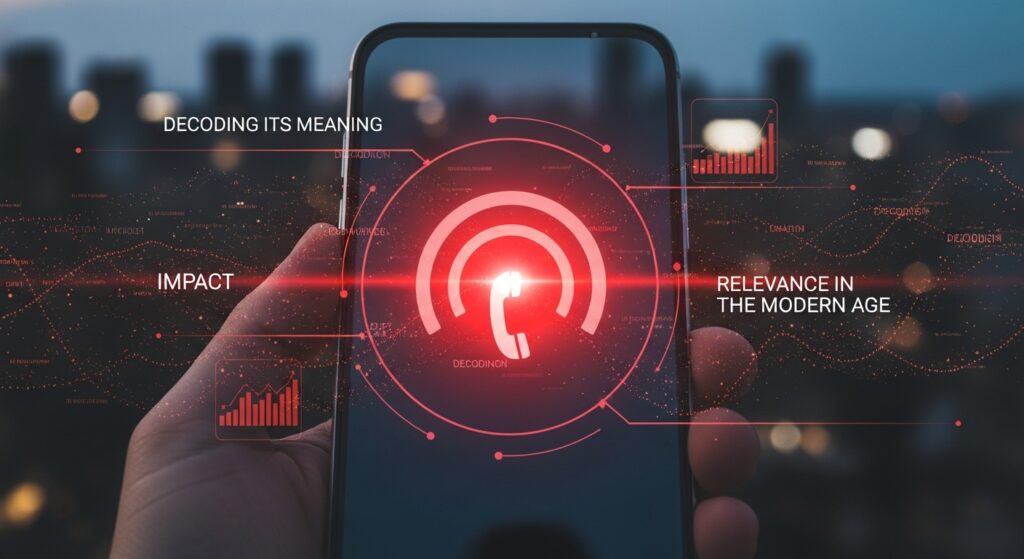In today’s hyperconnected world, communication is the backbone of personal life, business, and global interaction. From social networking apps to emergency alert systems, signals play a critical role in how we exchange information. Among the many signals that capture attention, few are as intriguing as the red phone signal.
This article explores the origins, symbolism, and modern applications of the red phone signal, highlighting why it remains a powerful emblem of urgency, authority, and trust in an era where digital communication is constantly evolving.
What Is the Red Phone Signal?
The red phone signal traditionally refers to a distinctive communication icon associated with direct, secure, and high-priority contact. Historically, it has been linked to:
-
Emergency communication lines between governments during times of crisis.
-
Priority alerts in organizations to signal urgency.
-
Symbolic representation in media and culture of immediate action or emergency authority.
More than just a literal signal, it carries psychological weight. Its color, form, and association with urgency create an unmistakable impression: when the red phone signal appears, attention must follow.
Historical Roots of the Red Phone Signal
The most iconic origin story of the red phone signal dates back to the Cold War era. Although the so-called “red telephone” hotline between the United States and the Soviet Union was never actually a phone, the image of a red signal phone became a global symbol of urgent, high-stakes communication.
Over time, this symbolism expanded into pop culture, business, and technology. It became shorthand for:
-
Immediate priority.
-
Critical decision-making.
-
Uninterrupted communication.
From films portraying presidents answering red phones to modern emergency systems flashing red icons, the image has endured as a cultural and practical symbol.
The Psychology Behind the Red Phone Signal
Why does the red phone signal stand out so strongly? The answer lies in psychology and design:
-
Color Red: Universally associated with urgency, warning, and attention.
-
Phone Icon: Represents communication, authority, and connection.
-
Combined Symbol: Together, they create an image of direct, high-priority communication that bypasses ordinary processes.
This explains why the red phone signal has been adopted in diverse contexts, from government systems to workplace software, as a way of saying: “This cannot wait.”
Modern Applications of the Red Phone Signal
Today, it extends far beyond Cold War symbolism. Its presence is felt in multiple industries:
1. Emergency Services
Police, fire, and medical systems often use variations of the red phone signal in their technology platforms to mark urgent communications that require immediate action.
2. Business Communication Tools
Corporate systems, especially in industries like finance, cybersecurity, and logistics, adopt the red phone signal as an icon for escalations, crisis management, or executive alerts.
3. Technology and Apps
Many mobile apps use red signals to mark critical notifications. While not always a phone icon, the influence of the red phone signal is visible in the way urgent messages are designed and delivered.
4. Media and Culture
Movies, TV shows, and literature continue to depict red phones as a metaphor for decisive action, leadership, and life-or-death choices.
Bridging Functionality with Symbolism
What makes it enduring is its dual identity:
-
Functional Tool: It serves a practical purpose in real-world communication systems.
-
Cultural Symbol: It represents urgency, authority, and responsibility.
This dual role gives it relevance both in serious emergency systems and as a metaphor in creative storytelling.
Influence in the Digital Age
In a time where digital notifications flood every device, it has gained new relevance. The challenge today is cutting through the noise. With countless pings, alerts, and pop-ups, people often experience “notification fatigue.”
It remains effective because it:
-
Commands attention in a sea of digital distractions.
-
Signals priority by being visually and symbolically distinct.
-
Builds trust by reassuring users that the message is critical, not trivial.
As communication platforms become more advanced, symbols like the red phone signal help establish a hierarchy of importance—ensuring that when seconds matter, the right message is seen first.
A Model for Next-Generation Alerts
The way the red phone signal has evolved provides lessons for future communication systems. Younger generations, especially Millennials and Gen Z, expect:
-
Authenticity: Signals should genuinely represent urgent matters, not be misused for marketing.
-
Transparency: Users want to know why an alert is critical.
-
Reliability: False alarms undermine trust in any system, no matter how powerful the signal.
By upholding these values, the red phone signal remains a trusted icon for high-priority communication in the modern era.
Challenges and Opportunities
Like any powerful tool, it faces challenges in today’s context:
-
Overuse and Dilution: If every notification uses “red” urgency signals, the symbol loses impact.
-
Balancing Technology with Human Judgment: Automated alerts must be carefully designed to avoid panic.
-
Cultural Adaptation: In some contexts, red may symbolize celebration or luck rather than danger.
Yet these challenges also open opportunities:
-
Designing smarter systems that use the red phone signal only when necessary.
-
Educating users on the meaning of urgency signals.
-
Expanding its role in hybrid communication systems, blending tradition with innovation.
Looking Ahead
As technology continues to reshape communication, it is unlikely to disappear. Instead, it will adapt—integrating into smart devices, AI-driven alerts, and global crisis systems. Its legacy as a symbol of authority and urgency ensures it will remain relevant in both practical and cultural spaces.
Looking ahead, expect the red phone signal to evolve into:
-
Smarter Digital Icons: Integrated into apps with contextual triggers.
-
Global Standardization: Adopted as a universal sign of emergency communication.
-
Cultural Storytelling: Continued use in film, literature, and media as a metaphor for leadership and responsibility.
Final Thoughts
The red phone signal is more than a simple icon—it is a cultural and technological beacon. From Cold War myths to modern emergency apps, it represents the universal need for urgent, reliable, and trustworthy communication.
In an age where attention is fragmented, the red phone signal endures as a reminder: some messages cannot wait. Whether guiding government leaders, supporting emergency responders, or alerting everyday citizens, its meaning is clear—when the red phone signal appears, action must follow.







